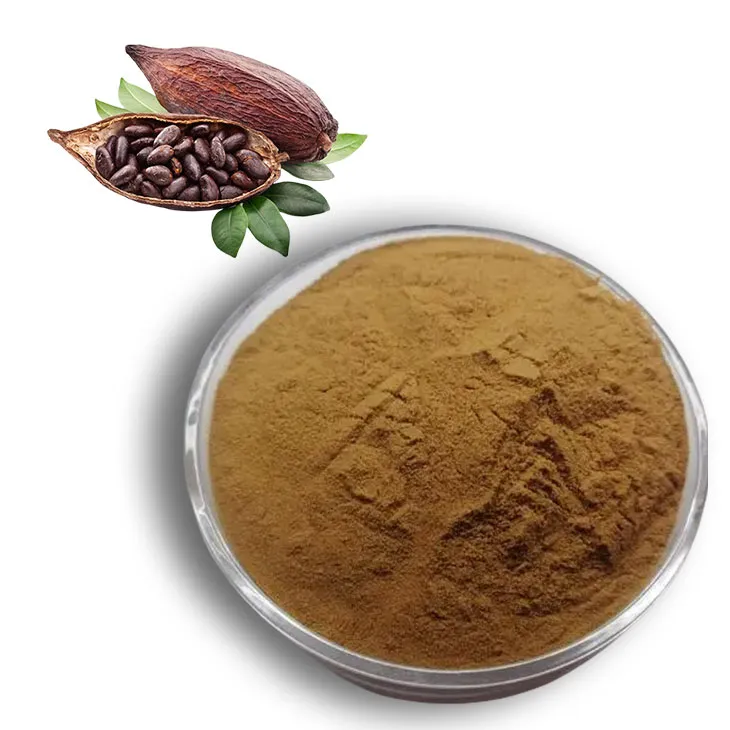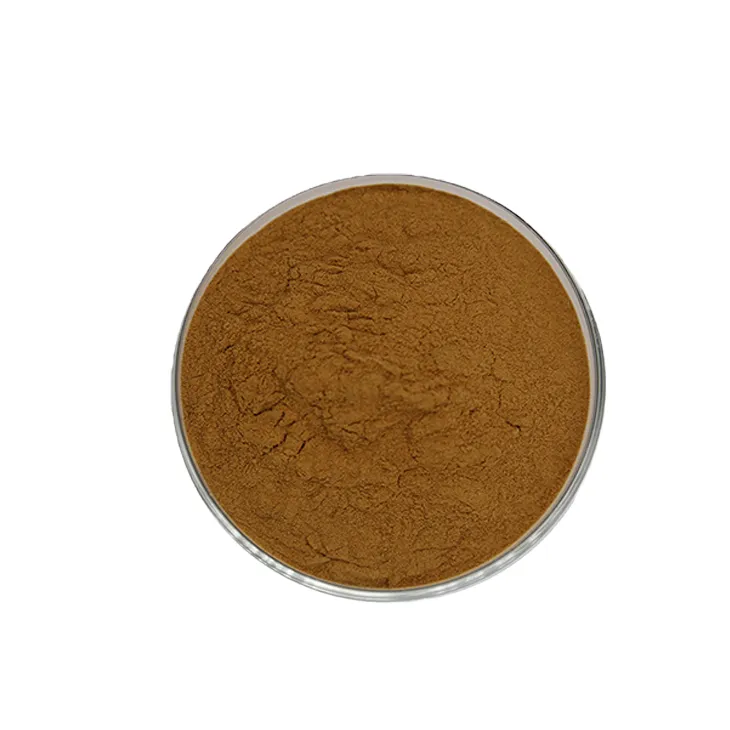- 0086-571-85302990
- sales@greenskybio.com
The process of extracting theobromine from cocoa extract.
2024-11-29

1. Introduction to Cocoa Extract
Cocoa Extract is a complex substance that contains a wide range of chemical components. It is the starting material for the extraction of theobromine. Cocoa beans, which are the source of Cocoa Extract, are rich in fats, proteins, and various bioactive compounds. Theobromine is one of the significant components in cocoa extract, and its extraction has both scientific and commercial importance.

2. Initial Preparation of Cocoa Extract
2.1 Homogenization
One of the initial steps in preparing the cocoa extract for theobromine extraction is homogenization. This process aims to ensure a uniform composition throughout the extract. By breaking down any large particles or aggregates, homogenization helps in creating a more consistent starting material for subsequent extraction steps. This can be achieved through mechanical means, such as using a high - speed mixer or a homogenizer. The resulting homogenized cocoa extract is more likely to interact evenly with the extraction solvents, leading to more efficient extraction of theobromine.
3. Solvent - Based Extraction
3.1 Selection of Solvents
When it comes to solvent - based extraction of theobromine from cocoa extract, the choice of solvent is crucial. Several factors need to be considered. Environmental impact is an important aspect. Solvents that are less harmful to the environment are preferred. For example, some organic solvents may have high volatility and contribute to air pollution, so alternative solvents with lower environmental footprints are being explored. Another key factor is extraction efficiency. Different solvents have different affinities for theobromine and other components in the cocoa extract. Some commonly considered solvents include ethanol, chloroform, and ethyl acetate. Ethanol, for instance, is a relatively safe and effective solvent in many cases. It can dissolve theobromine while also being miscible with water to some extent, which can be beneficial as cocoa extract contains some water - soluble components as well.3.2 Solvent - Extract Interaction
Once the solvent is selected, the interaction between the solvent and the cocoa extract is of great significance. The solvent needs to penetrate the cocoa extract matrix to access and dissolve the theobromine. This interaction is influenced by factors such as the polarity of the solvent and the chemical nature of the components in the cocoa extract. For example, if the solvent is polar, it will interact more favorably with polar components in the cocoa extract, which may or may not include theobromine depending on its own polarity characteristics. The solubility of theobromine in the solvent also depends on temperature and pressure conditions, which will be further explored in the extraction optimization section.
4. Extraction Optimization
4.1 Temperature Control
Temperature plays a vital role in the extraction process. Appropriate temperature settings can significantly enhance the extraction efficiency. At higher temperatures, the solubility of theobromine in the solvent may increase, allowing for more theobromine to be dissolved. However, if the temperature is too high, it may lead to the degradation of theobromine or other unwanted chemical reactions. For example, some components in the cocoa extract may react with the solvent at elevated temperatures, forming by - products that can contaminate the final theobromine product. Therefore, a careful balance needs to be struck. In most cases, a temperature range between 40 - 60 °C has been found to be effective for the extraction of theobromine using common solvents like ethanol.4.2 Pressure Considerations
Pressure is another parameter that can be adjusted during the extraction process. In some extraction methods, applying a certain amount of pressure can help the solvent to better penetrate the cocoa extract and dissolve the theobromine. However, like temperature, excessive pressure can also have negative impacts. It may cause physical damage to the extraction equipment or lead to the formation of unwanted chemical compounds. For example, in a high - pressure extraction system, if the pressure is not carefully controlled, it may cause the solvent to react with other components in the cocoa extract in an unexpected way. Usually, for solvent - based extraction of theobromine from cocoa extract, a moderate pressure range is maintained, depending on the specific solvent and extraction equipment used.4.3 Extraction Time
The extraction time also needs to be optimized. A longer extraction time may initially seem to be beneficial as it allows more time for the solvent to dissolve the theobromine. However, after a certain point, the extraction rate may slow down significantly, and there may be an increased risk of extracting unwanted components from the cocoa extract. For example, if the extraction time is too long, proteins or other large molecules in the cocoa extract may start to dissolve in the solvent, which can be difficult to separate from the theobromine later. Generally, extraction times can range from a few hours to several days, depending on the specific extraction conditions and the desired purity of the theobromine product.
5. Separation of Theobromine from Solvent
5.1 Distillation
Distillation is a common technique used to separate theobromine from the solvent system. In distillation, the solvent - theobromine mixture is heated. Due to the difference in boiling points between the solvent and theobromine, the solvent will vaporize first. The vapor is then condensed and collected separately, leaving the theobromine behind. For example, if ethanol is used as the solvent, its boiling point is much lower than that of theobromine. By heating the ethanol - theobromine mixture, the ethanol can be easily removed through distillation. However, distillation needs to be carefully controlled to ensure complete removal of the solvent without causing any damage to the theobromine.5.2 Solvent Evaporation
Another method for separating theobromine from the solvent is solvent evaporation. This method is often simpler and more cost - effective than distillation in some cases. The solvent - theobromine mixture is simply exposed to conditions that allow the solvent to evaporate, such as gentle heating or reduced pressure. As the solvent evaporates, the concentration of theobromine in the remaining mixture increases. However, similar to distillation, care must be taken to ensure that the theobromine does not degrade during the evaporation process. Also, any residues of the solvent left after evaporation need to be minimized to meet the quality requirements of the theobromine product.6. Advanced Purification of Theobromine
6.1 Ion - Exchange Chromatography
Ion - exchange chromatography is an effective method for further purifying the theobromine product. In this technique, the theobromine sample is passed through a column filled with ion - exchange resins. Depending on the charge characteristics of the theobromine and the resin, the theobromine will either be retained on the resin or pass through the column. Unwanted ions or impurities with different charge properties can be separated from the theobromine in this way. For example, if the theobromine has a positive charge and the resin is designed to attract negative ions, then negative - charged impurities can be removed from the theobromine solution as it passes through the column. This process can significantly enhance the purity of the theobromine product.6.2 Recrystallization
Recrystallization is another important purification step. The theobromine is dissolved in a suitable solvent at an elevated temperature. As the solution cools, the theobromine will crystallize out, leaving behind impurities in the solvent. The choice of solvent for recrystallization is crucial. It should be a solvent in which theobromine has a relatively high solubility at high temperatures and a much lower solubility at low temperatures. By carefully controlling the temperature and the concentration of the theobromine solution, a high - purity theobromine product can be obtained through recrystallization.7. Conclusion
The extraction of theobromine from cocoa extract is a complex process that involves multiple steps. From the initial preparation of the cocoa extract through solvent - based extraction, extraction optimization, separation of theobromine from the solvent, and finally advanced purification steps, each stage is crucial in obtaining a high - quality theobromine product. As research continues, new and more efficient methods may be developed to further improve the extraction and purification processes, which will have implications for various industries such as the food, pharmaceutical, and cosmetic industries that use theobromine in their products.
FAQ:
What are the initial steps in preparing cocoa extract for theobromine extraction?
The initial steps may involve homogenization to ensure the cocoa extract has a uniform composition, which is important for effective theobromine extraction.
How do you choose solvents for theobromine extraction from cocoa extract?
When choosing solvents, factors such as environmental impact and extraction efficiency are considered. Different solvents are evaluated based on these aspects to determine the most suitable one for theobromine extraction.
Why are temperature, pressure and extraction time important in theobromine extraction?
Temperature, pressure and extraction time are important parameters because they need to be carefully controlled for extraction optimization. Appropriate values of these parameters can ensure efficient extraction of theobromine from the cocoa extract.
What techniques are used to separate theobromine from the solvent?
Techniques like distillation or solvent evaporation are used to separate the theobromine from the solvent system after extraction.
How can the purity of the final theobromine product be enhanced?
Advanced purification steps such as ion - exchange chromatography or recrystallization can be implemented to enhance the purity of the final theobromine product.
Related literature
- The Chemistry of Theobromine Extraction from Cocoa - Based Materials"
- "Optimizing Theobromine Recovery from Cocoa Extract: A Review"
- "Advanced Techniques in Theobromine Isolation from Cocoa Extract"
- ▶ Hesperidin
- ▶ citrus bioflavonoids
- ▶ plant extract
- ▶ lycopene
- ▶ Diosmin
- ▶ Grape seed extract
- ▶ Sea buckthorn Juice Powder
- ▶ Beetroot powder
- ▶ Hops Extract
- ▶ Artichoke Extract
- ▶ Reishi mushroom extract
- ▶ Astaxanthin
- ▶ Green Tea Extract
- ▶ Curcumin Extract
- ▶ Horse Chestnut Extract
- ▶ Other Problems
- ▶ Boswellia Serrata Extract
- ▶ Resveratrol Extract
- ▶ Marigold Extract
- ▶ Grape Leaf Extract
- ▶ blog3
- ▶ blog4
-
Chinese sophora flower extract suppliers.
2024-11-29
-
如何用甜叶菊提取物制作粉末
2024-11-29
-
Kidney bean extract of the best quality.
2024-11-29
-
Optimal Bioavailability of Marigold Extract.
2024-11-29
-
American Ginseng Root Extract
2024-11-29
-
Hawthorn powder
2024-11-29
-
Alisma Extract
2024-11-29
-
Chasteberry Extract
2024-11-29
-
Alfalfa Meal
2024-11-29
-
Troxerutin
2024-11-29
-
Buckthorn bark extract
2024-11-29
-
Withania Somnifera Extract
2024-11-29
-
Moringa powder
2024-11-29
-
Green coffee bean Extract
2024-11-29





















